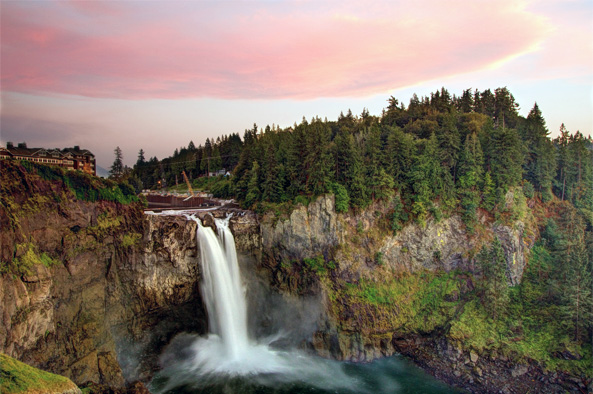
Snoqualmie Falls
| Status | Protected |
| Country | United States |
| Report By | Amy Corbin |
| Posted | August 1, 2004 |
| Updated | May 19, 2025 |

Snoqualmie Falls, 30 miles east of Seattle, Washington, is sacred to the Snoqualmie Tribe of the Puget Sound region. They believe it is the place where First Woman and First Man were created by Moon the Transformer, himself the son of an Indian woman and a star. There, at a huge fish weir built by Raven, Moon created a wonderful waterfall where prayers were carried up to the Creator by great mists that rise from the powerful flow. The area has been a traditional burial site for centuries. At 268 feet, the plunge of Snoqualmie Falls is 100 feet taller than Niagara Falls. Snoqualmie appeared in the opening sequence of the television series Twin Peaks and its power has always been a source of awe and inspiration for those who experience the falls in person. “The spirit is there to strengthen and heal us all,” says Lois Sweet Dorman, a spokesperson for the Snoqualmie. “The cycle of water renews us, for it is the cycle of life.”
History of the Conflict
In 1898, the Puget Sound Power & Light Company built a hydroelectric generating plant at the falls that has remained in operation for over a century. By blasting the face of the falls and excavating an underground cavern, the utility company channeled water through pipes to turbines at the base of the falls. The first power plant was completed in 1899, a second was added below the falls in 1957. Today, the renamed Puget Sound Energy diverts 93% of the river into its generators, and this tremendous amount of water has reduced the once majestic flow and mist to a trickling fraction of its former grandeur. The turbines provide less than one percent of the energy distributed by Puget Sound Energy. In 1989, the company filed an application with the Federal Energy Regulatory Commission (FERC) to renew its license for 40 years, increase its diversion of water from the falls and build new generating turbines. The extra power would serve an additional 7,500 customers.
The request offended the Snoqualmie people who were already unhappy about the sacrilegious operation and the fact that the power company, developers, tourists, and federal officials have consistently disregarded the spiritual and cultural significance of the falls to the tribe. They approached the Church Council of Greater Seattle which, in 1987, issued a letter of apology recognizing the Christian Church’s “longstanding participation in the destruction of Native American spiritual practices.” The churches pledged to support Native Americans in their attempt to preserve and reclaim their sacred places. Together, the Snoqualmie, the Church Council, and other citizens and religious groups formed the Snoqualmie Falls Preservation Project (SFPP) and began an activist/educational campaign to preserve Snoqualmie Falls in as natural a state as possible. The SFPP proposed the decommissioning of the hydroelectric power plant and envisioned a Spirit of the Falls Sanctuary Park that would be co-managed by the tribe. FERC rejected this proposal.
A new threat surfaced in the 1990s: the Falls Crossing Project. The Weyerhauser and Puget Western corporations proposed an enormous real estate development, including a 182-acre housing, retail and office complex adjacent to the falls. The city was going to rubber stamp the project until native activists began attending meetings, asking questions and voicing opposition. The SFPP began an intensive campaign to educate FERC, Congress, the 1.5 million people who visit the falls each year, and the general public in the state of Washington about the impact the proposed development would have on the falls. The Cascade Land Conservancy, King County and the City of Snoqualmie eventually joined in the Snoqualmie Preservation Initiative and in the negotiations to scale back the development project.
The Snoqualmie people and their allies believed this was the last opportunity to preserve and restore this sacred place “for all people, for all time.” They wanted the lease terminated so that Snoqualmie Falls could return to its natural state as the principal sacred site of the Snoqualmie people where, as the elders say, “the mists of the plunging waters connect heaven and earth.”
The Snoqualmie Preservation Initiative also focused on broader development and conservation issues crucial to ensuring protection of the Falls and the surrounding area. in 1992, the Snoqualmie Falls were recognized as a Traditional Cultural Property in the National Registry, the first to be recognized in Washington State. The Weyerhauser Real Estate Company (WRECO), which owned most of the land in the area, was also asked to negotiate to preserve Snoqualmie Falls and the surrounding valley. Measures were considered that would appeal to the interests of businesses, environmentalists and native people, and that would create a blueprint for future planning.
In January 2001, the Cascade Land Conservancy, funded by the city and county, purchased 145 acres of land near the Falls from Puget Western, Inc., owners of the Falls Crossing site. In March 2001, the Metropolitan King County Council unanimously approved the Snoqualmie Preservation Initiative, an agreement that would permanently protect the Falls, the watershed and the immediate area, and prohibit development on 9,000 acres of forest around the Falls.
Current Status
The Snoqualmie Falls Preservation Project continued through 2006. In 2015, the Tribe and allies established the Save Snoqualmie Falls campaign to fight yet another development threatening the site. The Tribe claimed victory on November 1st, 2019 by purchasing the Salish Lodge and Spa and a 45-acre area around the falls for $125 million.
However, Puget Sound Energy signed a 40-year lease to continue the hydroelectric project at the falls in 2004 despite the Tribe’s protests.
The Snoqualmie Tribe is still fighting to protect the site and exercising their legal rights over what happens at the falls.
Resources
The Snoqualmie Tribe Ancestral Lands Development website.
Snoqualmie Falls National Register of Historic Places Registration Form.